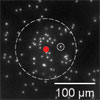Active Particles Generate Pressure
Active matter systems such as swimming bacteria, molecular motors or micro robots are of great biological and technological relevance. By confining microswimmers in an acoustic trap, the Soft Materials laboratory and a group at Caltech have for the first time measured the extra stresses generated by such systems.

Confinement of living microorganisms and self-propelled particles by an external trap provides a means of analysing the motion and behaviour of active systems. Developing a tweezer with a trapping radius large compared with the swimmers’ size and run length has been an experimental challenge, as standard optical traps are too weak. Here we report the novel use of an acoustic tweezer to confine self-propelled particles in two dimensions over distances large compared with the swimmers’ run length. We develop a near-harmonic trap to demonstrate the crossover from weak confinement, where the probability density is Boltzmann-like, to strong confinement, where the density is peaked along the perimeter.
At high concentrations the swimmers crystallize into a close-packed structure, which subsequently ‘explodes’ as a travelling wave when the tweezer is turned off. The swimmers’ confined motion provide the very first measurement of the swim pressure, a unique mechanical pressure exerted by self-propelled bodies.
